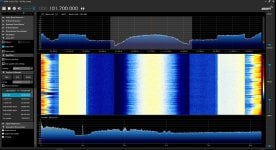Hello!
I want to preface this saying that I don't work in radio and don't work for any of these stations. I'm just an avid listener with equipment for viewing the signals from these stations. I might not even know what I'm talking about.
In the last few months, I've noticed more and more stations with crappy HD Radio encoders in my area. All of them seem to leak noise both into the station's analog signal as well as in adjacent channels. Using a software defined radio, I can demonstrate the actual spectrum of the signal, but I can also notice a difference just by the sound out of my analog FM radios.
Here's a screenshot of KQRS-FM during a period of little modulation. You can see how much the HD Radio sidebands leak into the analog signal of itself as well as how much it's leaking into the adjacent channels.

For comparison, here's a different station, KXXR, that doesn't suffer from the same problem. The cutoffs on the HD sidebands are very close.

KQRS also isn't the only station suffering from this problem. I can clearly see it happening on KEEY-FM, KDWB-FM, KSJN-FM, and KTCZ-FM too.

The interference caused to adjacent channels by KEEY and KDWB is enough to obliterate the HD signal on a more distant station I enjoy, WHMH, which is unfortunately squeezed between two of the noisy stations here. The HD signal on this station should be easily decodable but the edges of it are being "blocked out" by the rolloff of the local stations. WHMH's HD signal is decodable for a few seconds at a time but is usually impossible to synchronize to because of the interference.

Three of those four stations earlier also show the analog signal leaking into adjacent channels at modulation peaks too. This picture of KQRS zoomed out a few months ago really demonstrates how bad this interference is.

KQRS has since fixed this analog interference for the most part, but KEEY, KDWB, and KTCZ definitely haven't. I'm also fairly confident this isn't a result of my SDR overloading, as it's persisted for months and I actually happened to have been recording when KQRS switched on their noisy equipment for the first time. Here's a video of KQRS switching from their clean backup transmitter to their noisy primary transmitter.
Anyone else see any of these transmitters in their area? Anyone know what causes this? It's especially frustrating when the interference is causing me to be unable to decode the HD of other stations.
I want to preface this saying that I don't work in radio and don't work for any of these stations. I'm just an avid listener with equipment for viewing the signals from these stations. I might not even know what I'm talking about.
In the last few months, I've noticed more and more stations with crappy HD Radio encoders in my area. All of them seem to leak noise both into the station's analog signal as well as in adjacent channels. Using a software defined radio, I can demonstrate the actual spectrum of the signal, but I can also notice a difference just by the sound out of my analog FM radios.
Here's a screenshot of KQRS-FM during a period of little modulation. You can see how much the HD Radio sidebands leak into the analog signal of itself as well as how much it's leaking into the adjacent channels.

For comparison, here's a different station, KXXR, that doesn't suffer from the same problem. The cutoffs on the HD sidebands are very close.

KQRS also isn't the only station suffering from this problem. I can clearly see it happening on KEEY-FM, KDWB-FM, KSJN-FM, and KTCZ-FM too.

The interference caused to adjacent channels by KEEY and KDWB is enough to obliterate the HD signal on a more distant station I enjoy, WHMH, which is unfortunately squeezed between two of the noisy stations here. The HD signal on this station should be easily decodable but the edges of it are being "blocked out" by the rolloff of the local stations. WHMH's HD signal is decodable for a few seconds at a time but is usually impossible to synchronize to because of the interference.

Three of those four stations earlier also show the analog signal leaking into adjacent channels at modulation peaks too. This picture of KQRS zoomed out a few months ago really demonstrates how bad this interference is.

KQRS has since fixed this analog interference for the most part, but KEEY, KDWB, and KTCZ definitely haven't. I'm also fairly confident this isn't a result of my SDR overloading, as it's persisted for months and I actually happened to have been recording when KQRS switched on their noisy equipment for the first time. Here's a video of KQRS switching from their clean backup transmitter to their noisy primary transmitter.
Anyone else see any of these transmitters in their area? Anyone know what causes this? It's especially frustrating when the interference is causing me to be unable to decode the HD of other stations.

